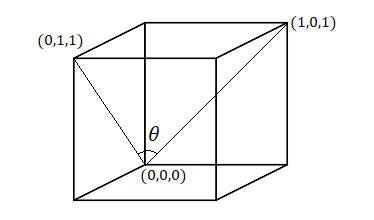
In a unit cube. Find the angle between the diagonals of two faces of the cube through the same vertex?
Answer
448.2k+ views
Hint: To answer this question we have to consider a unit cube first and then we should consider any two faces with the same vertex and then draw the diagonals. we should find the vectors from the diagonals as we have the points forming the diagonals. From this we can consider the angles between them with the formula of angle between two vectors.
Complete step by step solution:
The given problem can be drawn in figure as shown below,

Let us consider two faces in the figure,
Now let us join the points (0,0,0) to (1,0,1) and (0,0,0) to (0,1,1)
Vector representations of the diagonals joining the points (0,0,0) to (1,0,1) is as below,
So,
Vector representations of the diagonals joining the points (0,0,0) to (0,1,1) is as below,
So,
Let θ be the angle between the two vectors.
We know,
So the angle required between the diagonals of two faces of the cube through the same vertex is given as
Note: Students have to consider the unit cube as shown with the required diagonals as any mistake in this step can lead to wrong answers. The formula to find the angle between two vectors should be known to get the angles between the diagonals.
Complete step by step solution:
The given problem can be drawn in figure as shown below,

Let us consider two faces in the figure,
Now let us join the points (0,0,0) to (1,0,1) and (0,0,0) to (0,1,1)
Vector representations of the diagonals joining the points (0,0,0) to (1,0,1) is as below,
So,
Vector representations of the diagonals joining the points (0,0,0) to (0,1,1) is as below,
So,
Let θ be the angle between the two vectors.
We know,
So the angle required between the diagonals of two faces of the cube through the same vertex is given as
Note: Students have to consider the unit cube as shown with the required diagonals as any mistake in this step can lead to wrong answers. The formula to find the angle between two vectors should be known to get the angles between the diagonals.
Recently Updated Pages
Master Class 12 Business Studies: Engaging Questions & Answers for Success

Master Class 12 English: Engaging Questions & Answers for Success

Master Class 12 Social Science: Engaging Questions & Answers for Success

Master Class 12 Chemistry: Engaging Questions & Answers for Success

Class 12 Question and Answer - Your Ultimate Solutions Guide

Master Class 12 Economics: Engaging Questions & Answers for Success

Trending doubts
The gas that burns in oxygen with a green flame is class 12 chemistry CBSE

Most of the Sinhalaspeaking people in Sri Lanka are class 12 social science CBSE

Give 10 examples of unisexual and bisexual flowers

Draw a labelled sketch of the human eye class 12 physics CBSE

Differentiate between homogeneous and heterogeneous class 12 chemistry CBSE

Write a short note on Franklands reaction class 12 chemistry CBSE




